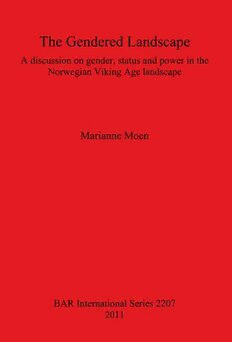
The Gendered Landscape: A discussion on gender, status and power in the Norwegian Viking Age landscape PDF
83 Pages·2011·5.4 MB·English
Most books are stored in the elastic cloud where traffic is expensive. For this reason, we have a limit on daily download.
Preview The Gendered Landscape: A discussion on gender, status and power in the Norwegian Viking Age landscape
Description:
This study is the result of a long standing interest by the author in the expression of social identities of the past, perhaps more specifically, social identities as translated through gender, and their resulting cultural expressions and material remains. The overarching subject explored is the gender structures prevalent in the Late Iron Age in the county of Vestfold, Norway. The Scandinavian Late Iron Age, popularly known as the Viking Age, is often represented as deeply and inherently male, with male aggressiveness as the ideal presented to the public, leaving little room for alternative gender roles in the popular imagination. Gender is one of the basic structuring principles of most societies, and as a social category it must be understood in order to grasp the cultural complexity of a society. The author will attempts to show that the gender roles of the Viking Age are perhaps often interpreted and represented too simplistically, and that popular stereotypes fail to take into account the complex multitude of categories, variations and negotiations which one ought to expect from the interpretation of gender. The author's basic proposition is that if the gender roles of the Viking Age were more complex than is often believed, this may be reflected in the mortuary landscape and in the choice of location for burials. To approach this subject, the author looks at the relative positioning of female graves in the mortuary landscape of the Viking Age, and focuses on two different sites in the county now known as Vestfold: Oseberg and Kaupang.
See more
The list of books you might like
Most books are stored in the elastic cloud where traffic is expensive. For this reason, we have a limit on daily download.
